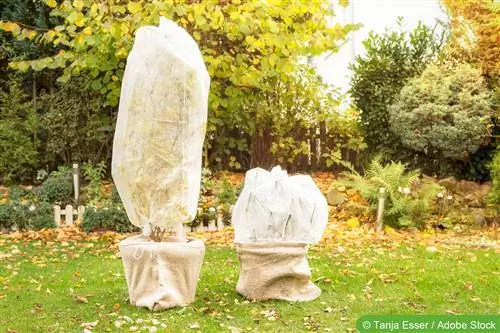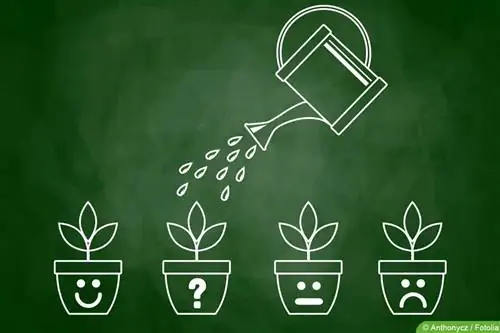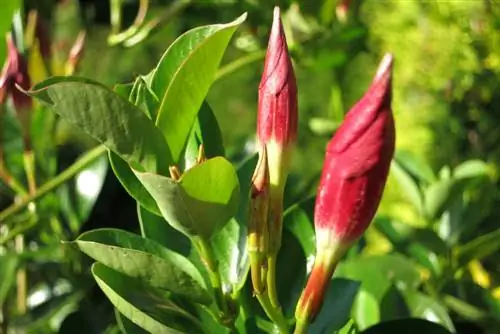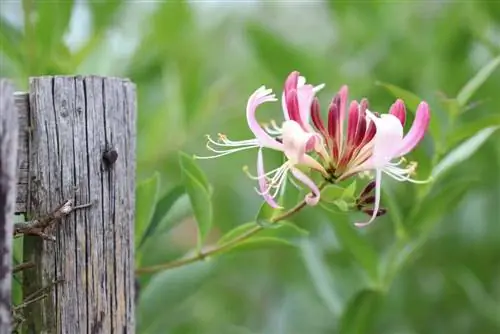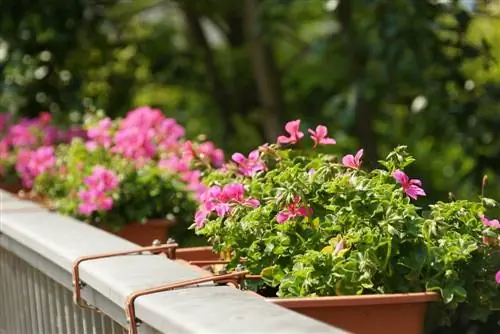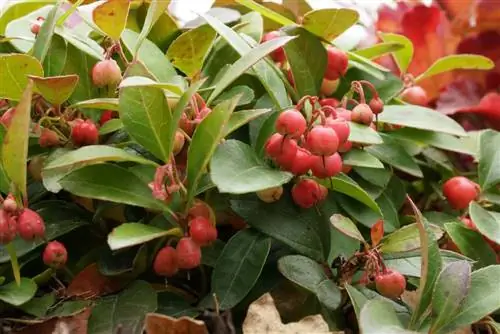- Author admin [email protected].
- Public 2023-12-17 03:39.
- Last modified 2025-01-24 12:45.
A real space problem for some hobby gardeners. In a protected location and with the right precautions, potted plants can overwinter outside.
Which potted plants can overwinter outside?
Bamboo, cherry laurel and conifers overwinter directly in the garden. However, the frost-sensitive roots should be well covered to protect against ground frost. Oleanders, modern types of geraniums, vines and palm trees are usually brought in before the first frosts, but can also overwinter outside. All plants that create beautiful contrasts in the garden bed in pots, but also serve as garden plants, can also be overwintered outside. These include:
- Boxwood,
- Yews,
- Cherry Laurel
- or large-flowered hibiscus plants
If you want to plant pots and don't have enough space inside for winter storage, you should seek advice when purchasing.
Choose the right location
Plants should be in their natural environment for as long as possible. If you want to overwinter your potted plants outside, you should prepare the pots well. The right location is necessary for successful outdoor wintering. Choose the space carefully. Wind protection and a certain level of protection from too much rain and snow should be guaranteed. Close to a house wall on the balcony or terrace offers good protection. When choosing the location, please make sure that you can easily reach the place for watering.
Do not place the pots directly on the ground, but raise the location. A Styrofoam plate, which you can get from specialist retailers, offers good insulation against the cold of the floor. The motto should be a little more rather than too little.
Prepare and protect the bucket well
Before the bucket is moved to its intended location, it should be well cleaned of dirt and weeds. The potted plants should be pest-free to prevent pests or diseases from spreading to other plants. Plants with pest infestations should be overwintered in isolation from other plants. There may be insects at the bottom of the bucket, which must also be removed.
Multiple planted containers are cleared of all annual plants and filled with fresh soil. Potting soil that has already been enriched with fertilizer is available from specialist retailers. Repotting is not necessary. Dry branches or flowers are carefully removed. Since most plants do not have a growth phase in winter, additional fertilizing is not necessary. The soil is hilled up a little to protect the frost-sensitive roots.
To protect against frost, the bucket can also be wrapped with insulating materials. Bubble wrap, fleece, reeds or jute are suitable for this. The materials keep out the cold and offer excellent protection against the cold. The plant itself is only wrapped with air and moisture permeable materials so that waterlogging does not form inside. This prevents the formation of pests and diseases. Wrapping the plants or covering the soil with brushwood or pine greens also provides excellent protection from the cold.
Overwinter potted plants outside
Once all preparations have been completed, the potted plants are brought to the prepared location. The most frost-sensitive plants, such as oleander, go directly to the house wall, while the other plants are placed in front of them. The tubs can be placed close together, but not crowded. Depending on how sensitive it is to frost, the area can also be protected from wind and cold with covers. Permeable and natural materials, such as wood or fabric panels, are good options.
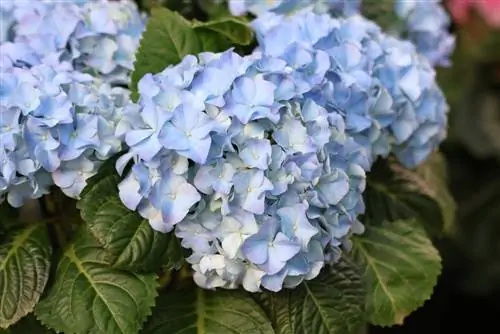
Regularly checking the plants in winter is important. If there is no moisture coming to the potted plants or if there is no precipitation for a longer period of time, the plants need to be watered. The root ball must not dry out. Watering is recommended at frost-free temperatures and only in small quantities so that the soil in the bucket does not freeze when frost sets in.
Successful overwintering ensures beautiful flowers
With a little effort, the potted plants can overwinter safely outdoors, remain free from damage caused by frost or disease and will soon beautify the garden with their splendor of flowers. As soon as the first mild and frost-free temperatures are reported in early spring, the potted plants can slowly be removed from protection. Many potted plants can tolerate temperatures slightly below zero. The protection around the bucket and the base cover can still be left and gradually removed.
What you should know about overwintering potted plants in brief
Unfortunately, in our latitudes, many plants can only be cultivated in containers because they are simply not winter-hardy: palm trees, banana trees, citrus trees, figs, oleander, mallow, passionflower, leadwort, pomegranate, olive, hemp palm and many others tolerate it only limited or no frost at all. They need winter quarters. However, under certain circumstances and with the help of some protective devices, you can overwinter some partially hardy potted plants outdoors. These plants include bamboo, boxwood, oleander, bananas, conifers, cherry laurel and some others.
Winter Protection & Precautions
- The most important thing is to protect the frost-sensitive roots. To do this, you can place the buckets on Styrofoam plates, boards, thick felt mats or similar.
- You should also wrap the planter with jute, felt, reeds, burlap or thick bubble wrap.
- The shoots can also be covered with leaves, straw or brushwood or you can simply wrap the packaging of the planter higher.
- Evergreen plants should be wrapped in fleece or shade nets to reduce sunlight and prevent evaporation through the leaves.
- Put everything together in a dry, wind-protected place.
When overwintering outdoors, it should not be forgotten that these plants also need water. However, there is much less watering. Usually there is enough water to prevent the bales from drying out. It is best to check the plants weekly. Frozen soil does not absorb moisture, so it does not need to be watered. Hot water for irrigation is harmful. It is better to wait until the soil has thawed and only then water.
Protect from drying out due to frost
- If the frost period lasts too long, it is advisable to place the plants in the warm for about two days so that the soil can thaw. Then you can water.
- The following day you put the buckets outside again. This procedure is laborious, but prevents the plants from dying of thirst.
- Older plants are more resilient than young ones. By getting used to it, potted plants can tolerate a lot of cold. When overwintering outdoors, it is important to stop fertilizing from August onwards. This allows the shoots to mature properly and not freeze so quickly.

